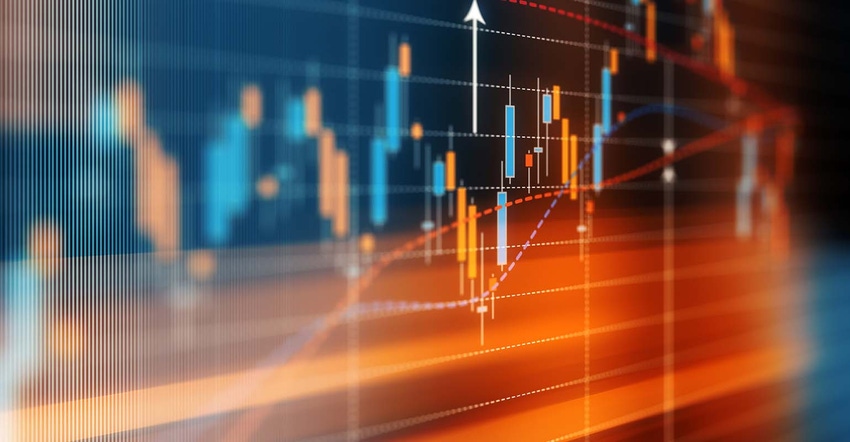
There are two ways to analyze commodity markets: fundamental analysis and technical analysis.
Most farmers are familiar with fundamental analysis; the study of supply and demand such as weather, exports, yield, etc. Fundamental analysis appeals to our sense of logic. When there is a drought, supply drops and therefore prices should rise.
But technical analysis has proven just as capable in studying future price movements.
How it works
Technical analysis operates under the assumption that it is impossible for any one person to be able to decipher all of the information that is out there at any given time, and that by the time the information reaches you, the market has already reacted to it.
For example, when Asian Rust hurt the Brazilian soybean crop in 2003, most likely companies such as Cargill were aware of this before others did, due to the fact they had staff and operations in those regions. More than likely by the time you heard about it, the market had already reacted.
The technical trader also recognizes that price movement develops trends which help to identify future price patterns. I know many technical traders who actively avoid reading fundamental information so as to not compromise or influence their technical strategies.
If a technical trader believes a market to be overbought and is looking to sell, he may be persuaded if he reads an article about how the price is expected to continue its rise. For them, the holy grail of future price movements is not found in any USDA report, but rather it is the price movement itself.
Technical analysts believe trends are born from psychological behavior culminating from each trader’s personal bias. Greed, remorse, fear and anxiety all play a role in defining market trends and have been shaping markets since markets began. The premise is that humans will behave similarly to the way they have in prior, related circumstances.
Predictable results?
This behavior creates trading ranges which then have potential to create predictable results. These ranges are rarely identical, but it is no coincidence that the trading range in corn has maintained its trading range between $3 and $4 for the last six years. Human behavior has identified these areas as being oversold or overbought, and each year it continues to happen, it reinforces that belief.
Last fall’s run up in price and subsequent fall is a prime example. Had a technical trader not been aware of any pending drought, they still would have reacted to the price movements. By responding to market breakouts, they helped propel the prices even higher. Stop orders were triggered, pushing longs out of the market. Furthermore, many farmers hearing the news of higher prices withheld sales, expecting it to go higher (which it did for a time), while subsequently buying even more contracts. An increase in sales would have potentially slowed or otherwise altered the market trajectory.
Hundreds of indicators
Technical analysts have hundreds of indicators that use previous price action to help predict future price action. Resistance and support levels, volume, open interest and relative strength index are some of the more common tools. “Bollinger bands” for example, create a moving envelope that surrounds the market price. As the price moves towards the top end of the envelope, traders consider this to be overbought which could be a signal to sell and vice versa it could be a signal to buy if the market price touches the bottom end of the envelope.
Managed money (fund trading) is also commonly quoted by technical analysts. While we can’t ever know specifically who is trading what, large investment funds leave a “footprint” for us to follow.
Every Friday the CFTC updates these trades by telling us what percent is long or short the market. For example, we know on May 12th that managed money funds are short a net 214,054 contracts in corn and long a net 32,465. While this is no silver bullet, it tells us that fund managers are overly bearish corn while slightly bullish soybeans.
This matters because they have the size to generate enough momentum to push the market where they want to go.
The best approach?
So which indicator is the right one? The answer is there is no right one. Each indicator has their pros and cons and none of them work all of the time. It ultimately depends upon what you are comfortable with.
For me, the best approach is when fundamental strategy agrees with that of technical action in the market. A combination between the two are ideal, because it provides a stronger confirmation of what is to come.
Contact Matthew Kruse at 712-227-1110 or email [email protected].
Futures trading involves risk. The risk of loss in trading futures and/or options is substantial and each investor and/or trader must consider whether this is a suitable investment. Past performance is not indicative of future results. Trading advice is based on information taken from trades and statistical services and other sources that CommStock Investments believes to be reliable. We do not guarantee that such information is accurate or complete and it should not be relied upon as such. Trading advice reflects our good faith judgment at a specific time and is subject to change without notice. There is no guarantee that the advice we give will result in profitable trades.
The opinions of the author are not necessarily those of Farm Futures or Farm Progress.
About the Author(s)
You May Also Like






